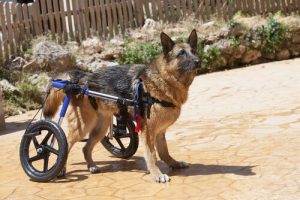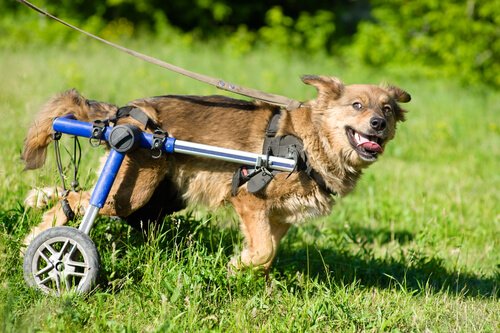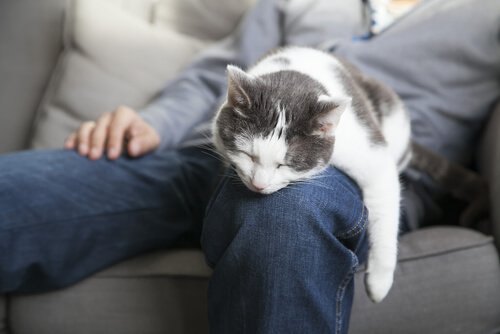Would You Adopt a Pet with Disabilities?

A pet with disabilities involves much more responsibility than adopting other types of pets. This is because in addition to requiring daily day-to-day care, such as taking it out for a walk, cleaning its litter box, feeding it, bathing it, and playing with it, it will also require special care due to its limitations.
However, all those who have carried out the charitable and generous act of adopting a pet with disabilities wouldn’t regret doing so. Why? According to many who have been asked, it is because these animals who have disabilities are much more loving, tender and thankful than those who do not.
Paperwork for adopting pets with disabilities

The procedures for adopting a pet with some type of disability are somewhat different than those for bringing home a completely healthy animal.
The first step is to set up a meeting with your veterinarian. The professional will be able to explain in detail to the adopter what the animal’s disability is, its cause, and what kind of care and medicine it may require.
The adopter must listen carefully and evaluate the time, energy and resources that this will entail, as well as the adjustments he might have to make in his home and family. If after a deep evaluation, the adopter is apt and willing to abide by that responsibility, and can cover the costs involved, he becomes the “dad” of his new pet.
It’s not like that in all cases. Some organizations just want to find someone who claims that they are going to take care of the animal. In others, they offer discounts in veterinary clinics to alleviate the economic burden that a pet with disabilities implies.
What to keep in mind if you have a disabled dog at home
A pet with a disability should not be treated the same way as one that is not disabled. We’re not talking about feeling sorry for him, or thinking that we can’t touch him for fear of hurting him. We’re talking about a disabled animal having different needs.

How to respect a pet with disabilities
- Give him his space. Every animal needs space when he first comes home. Think about how you feel when arriving in an unknown place for the first time. However, a disabled pet may need a little more time to adapt. Let him walk around the house, smell things, see every corner. All of this depends also on the type of disability he has.
- Take his limitations into account. Depending on what disability your new friend has, you will have to consider how to make his life easier. If, for example, he has a limp, and finds it hard to climb or go down stairs, try to put his toys, bed and dishes in a flat place without ups or downs. If he is blind, put all of his things in a space where there is no furniture in between. We’re sure your empathy will help you discover how to help your friend.
- Don’t skimp on vet expenses. Your pet may look good, but if your vet has told you he needs constant medical checkups, don’t let pass on those. Your pet’s life depends on it.
- Give him love, love and more love. This is the key to make any animal happy, whether he has a disability or not. Although, love is even more necessary in the case of a disabled pet. Your animal’s disability may have been caused by abuse, so love will be the best medicine for his afflicted soul.
With a little effort, affection and sincere love, you can greatly enjoy living with your pet, and make him a very happy animal.
A pet with disabilities involves much more responsibility than adopting other types of pets. This is because in addition to requiring daily day-to-day care, such as taking it out for a walk, cleaning its litter box, feeding it, bathing it, and playing with it, it will also require special care due to its limitations.
However, all those who have carried out the charitable and generous act of adopting a pet with disabilities wouldn’t regret doing so. Why? According to many who have been asked, it is because these animals who have disabilities are much more loving, tender and thankful than those who do not.
Paperwork for adopting pets with disabilities

The procedures for adopting a pet with some type of disability are somewhat different than those for bringing home a completely healthy animal.
The first step is to set up a meeting with your veterinarian. The professional will be able to explain in detail to the adopter what the animal’s disability is, its cause, and what kind of care and medicine it may require.
The adopter must listen carefully and evaluate the time, energy and resources that this will entail, as well as the adjustments he might have to make in his home and family. If after a deep evaluation, the adopter is apt and willing to abide by that responsibility, and can cover the costs involved, he becomes the “dad” of his new pet.
It’s not like that in all cases. Some organizations just want to find someone who claims that they are going to take care of the animal. In others, they offer discounts in veterinary clinics to alleviate the economic burden that a pet with disabilities implies.
What to keep in mind if you have a disabled dog at home
A pet with a disability should not be treated the same way as one that is not disabled. We’re not talking about feeling sorry for him, or thinking that we can’t touch him for fear of hurting him. We’re talking about a disabled animal having different needs.

How to respect a pet with disabilities
- Give him his space. Every animal needs space when he first comes home. Think about how you feel when arriving in an unknown place for the first time. However, a disabled pet may need a little more time to adapt. Let him walk around the house, smell things, see every corner. All of this depends also on the type of disability he has.
- Take his limitations into account. Depending on what disability your new friend has, you will have to consider how to make his life easier. If, for example, he has a limp, and finds it hard to climb or go down stairs, try to put his toys, bed and dishes in a flat place without ups or downs. If he is blind, put all of his things in a space where there is no furniture in between. We’re sure your empathy will help you discover how to help your friend.
- Don’t skimp on vet expenses. Your pet may look good, but if your vet has told you he needs constant medical checkups, don’t let pass on those. Your pet’s life depends on it.
- Give him love, love and more love. This is the key to make any animal happy, whether he has a disability or not. Although, love is even more necessary in the case of a disabled pet. Your animal’s disability may have been caused by abuse, so love will be the best medicine for his afflicted soul.
With a little effort, affection and sincere love, you can greatly enjoy living with your pet, and make him a very happy animal.
This text is provided for informational purposes only and does not replace consultation with a professional. If in doubt, consult your specialist.








